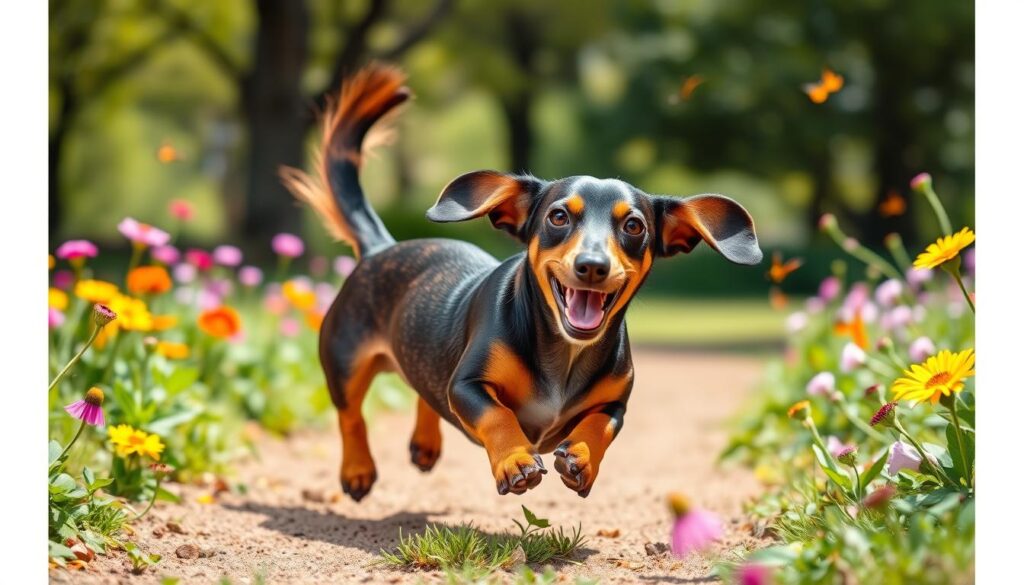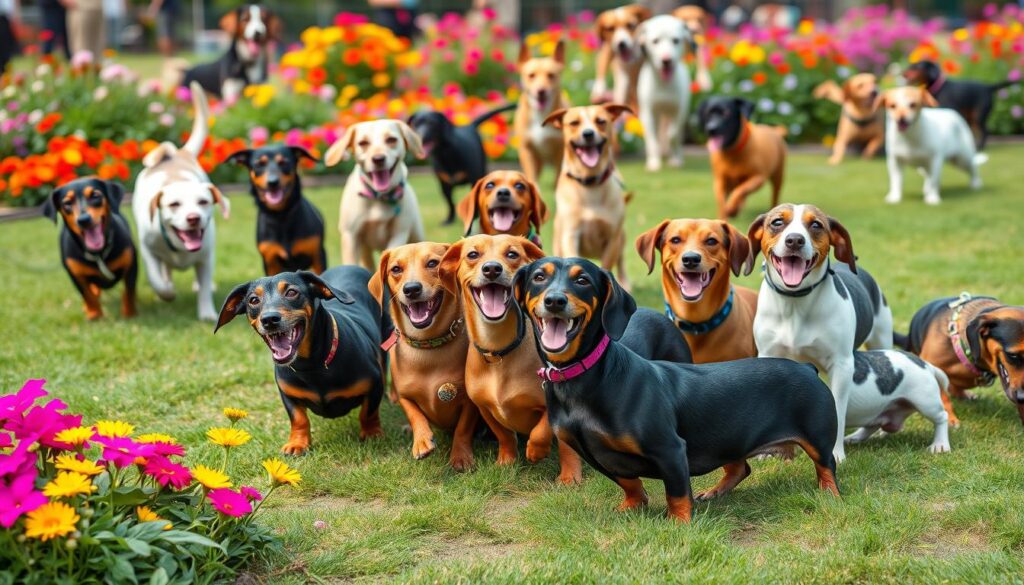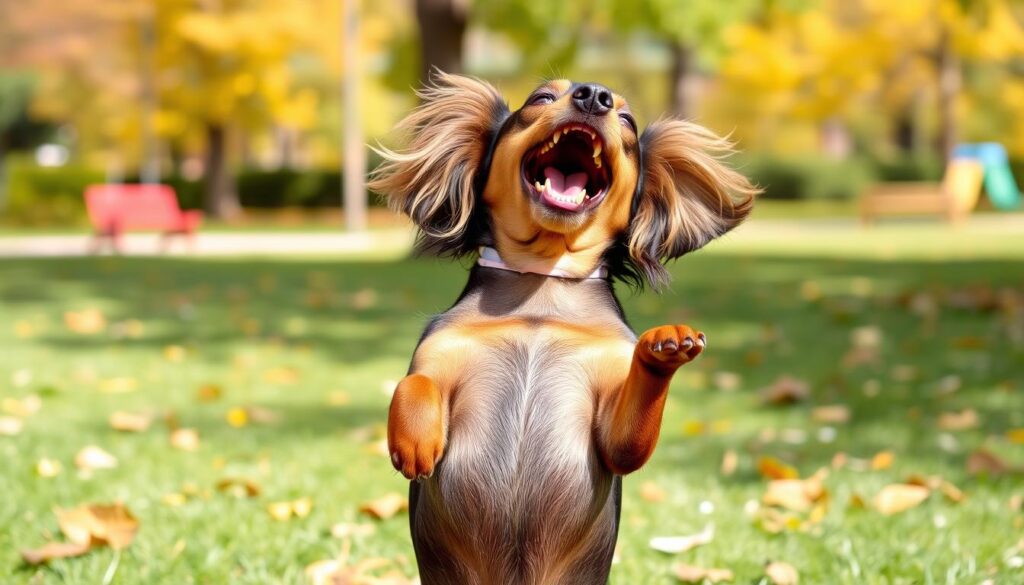Ever wondered why Dachshunds, those charming sausage-shaped dogs, capture hearts with their unique blend of sass and affection? These pint-sized pooches pack a personality that’s as distinctive as their elongated bodies. From their loyal nature to their stubborn streak, Dachshunds offer a fascinating mix of traits that make them stand out in the canine world.
Dachshunds, often called wiener dogs or sausage dogs, come in various coat types and sizes. Their personality is a delightful cocktail of courage, playfulness, and unwavering loyalty. These little dogs possess an intelligence that can sometimes border on stubbornness, making them both entertaining and challenging companions.
Whether you’re considering adding a Dachshund to your family or simply curious about these charismatic canines, understanding their temperament is key. Let’s dive into the world of Dachshunds and uncover the traits that make them such beloved pets in Australia and beyond.
Key Takeaways
- Dachshunds are known for their loyal and affectionate nature
- They possess a brave and curious temperament rooted in their hunting background
- Dachshunds can be stubborn, making training a bit challenging
- Their playful disposition makes them excellent family companions
- Dachshunds come in three coat varieties and two size categories
- They require proper socialization and consistent training for best behavior
Introduction to Dachshund Breeds
Dachshunds are loved for their unique shape and lively personalities. They come in different sizes and coat types. Originating from Germany, they have won hearts around the world with their special traits.
Smooth, Wirehaired, and Longhaired Varieties
Dachshunds have three main coat types: smooth, wirehaired, and longhaired. Smooth Dachshunds are the most common in the U.S. They have short, sleek fur. Wirehaired Dachshunds have wiry coats and are often playful.
Standard and Miniature Sizes
Dachshunds come in two sizes: standard and miniature. Standard Dachshunds weigh 16 to 32 pounds and are 8 to 9 inches tall. Miniature Dachshunds are smaller, weighing up to 11 pounds and standing 5 to 6 inches tall.
Historical Background and Purpose
Dachshunds were bred to hunt badgers. Their long bodies and large chests were perfect for digging. Today, they are brave and independent pets. They are known for their loud barks, despite their small size.
| Characteristic | Standard Dachshund | Miniature Dachshund |
|---|---|---|
| Weight | 16-32 pounds | Up to 11 pounds |
| Height | 8-9 inches | 5-6 inches |
| Lifespan | 12-16 years | 12-16 years |
Choosing a smooth, wirehaired, or longhaired Dachshund brings courage, love, and charm into your life. They have been popular since the 1950s.
The Brave and Curious Nature of Dachshunds

Dachshunds, also called “sausage dogs,” may be small but they have big personalities. They were bred in Germany for hunting badgers, making them fearless and adventurous. This history has shaped their bold and curious nature.
Despite their size, dachshunds are very brave. They face bigger animals without fear, showing their courage. But, their boldness can sometimes lead to risky behavior. So, it’s crucial to watch them closely.
Dachshunds are also very curious. They love to explore new things, always eager to check out new sights and smells. This curiosity makes them great friends for people who love to be active and go on adventures.
“Dachshunds are clever, lively, and courageous to the point of rashness.”
While their bravery and curiosity are fun, they can also be challenging. Their fearless nature might get them into trouble, and they can be stubborn. But, with the right training and lots of mental stimulation, you can help them stay happy and well-balanced.
Intelligence and Problem-Solving Abilities
Dachshunds are clever dogs with a knack for solving problems. Their intelligence is evident in many situations, making them both fun and challenging pets.
Independent Thinking
These tenacious little hounds have minds of their own. You’ll often find your dachshund coming up with creative solutions to get what they want. This independent streak is part of their charm but can lead to some dachshund training challenges.
Challenges in Training
Training a stubborn dachshund requires patience and consistency. Their strong-willed nature means they might not always see eye-to-eye with your commands. Positive reinforcement works best to overcome these hurdles.
Stubbornness and Determination
The tenacious dachshund is known for its unwavering determination. This trait, while admirable, can make training a bit tricky. You’ll need to be just as persistent as your furry friend to ensure they learn and follow rules.
“Dachshunds are clever enough to outsmart their owners, but loving enough to make you forgive them every time.”
Remember, your dachshund’s intelligence and stubbornness are part of what makes them unique. With the right approach, you can channel these traits into positive behaviors, creating a well-behaved and happy companion.
Loyalty and Affection Towards Family
Dachshunds are known for their loyalty and love for their families. They form strong bonds with their owners, making them great companions. Their loyalty to family is a key trait of the breed.

Studies show dachshunds often bond strongly with one family member. This bond doesn’t always depend on who spends the most time with them. It can be based on personality or an unexplained connection.
Their love can sometimes turn into jealousy or possessiveness. It’s important to involve all family members in their care and activities. Socializing them helps make them friendly and well-rounded pets.
| Trait | Percentage of Dachshunds |
|---|---|
| Outgoing and Friendly | 85% |
| Excessive Barking | 15% |
| Separation Anxiety (Males) | Higher than females |
Dachshunds love being around people, but each type has its own personality. Smooth-haired ones might be less outgoing, while long-haired ones are easier to train. Wire-haired dachshunds are friendly but can be scared during thunderstorms.
To deepen your bond with your dachshund, try activities like grooming, playing, and training. Remember, their love is a precious gift that makes your family life richer.
Dachshund Temperament and Personality Traits
Dachshunds are known for their unique temperament. They mix charm with mischief. These little dogs have big personalities, making them great companions.
Outgoing and Friendly Disposition
Dachshunds are outgoing and friendly. They love to meet new people. Their warm nature makes them perfect family dogs, always ready to welcome visitors.
Lively and Playful Nature
Dachshunds are full of energy and love to play. Despite their short legs, they’re always up for a game. They need about 60 minutes of exercise daily to stay fit.

Courageous to the Point of Rashness
Dachshunds are brave and fearless. They often act bigger than they are. This bravery can sometimes lead to reckless behavior, especially with larger dogs or new situations.
| Trait | Description | Impact on Care |
|---|---|---|
| Outgoing | Loves meeting new people | Needs regular socialization |
| Lively | Energetic and playful | Requires daily exercise |
| Courageous | Fearless in face of challenges | May need supervision in new situations |
Understanding dachshund temperament is key to caring for them. Their friendly, lively, and courageous nature brings joy to any home. Dachshunds are known for their loyalty and intelligence, but they can also be quite stubborn at times. This is where Dachshund Training becomes crucial. Consistent and patient training will help to channel their strong-willed nature and ensure they are well-behaved members of the family. It’s important to use positive reinforcement techniques and to start training early to establish good habits. By understanding their temperament and putting in the effort to train them properly, Dachshunds can make wonderful companions for any household.
Social Behavior and Interaction with Other Dogs
It’s important to understand how dachshunds behave socially. These lively dogs can be friendly, but early socialization is key. Their comfort around other dogs depends on their personality and past experiences.

Size is a factor in how dachshunds interact with other dogs. Their long bodies and short legs can make them feel scared around bigger dogs. This might cause them to act defensively. To help your dachshund feel more confident:
- Start socializing between 3 and 14 weeks of age
- Use positive reinforcement during interactions
- Expose them to various stimuli gradually
- Arrange controlled meetings with well-behaved dogs
Introducing your dachshund to new dogs needs patience and careful watching. Choose places like parks for first meetings. Keep both dogs on leashes and let them get used to each other from afar. Look for signs of discomfort or aggression, and reward calm behavior with treats.
Every dachshund is different. Some may take longer to get used to other dogs, especially if they’re adults. If you face ongoing issues, consider getting help from a professional dog trainer or behaviorist.
Energy Levels and Exercise Needs
Dachshunds are full of energy and have a lively personality. They need regular exercise to stay healthy and avoid getting too fat. Knowing how much exercise they need is important to keep them happy and active.
Daily Activity Requirements
Dachshunds need about 30 minutes to an hour of exercise every day. This can be walks, playtime in the yard, or indoor games. Their short legs might look funny, but they can run a lot! It’s better to have two shorter walks than one long one.
Importance of Mental Stimulation
Exercise is not enough for dachshunds. They also need mental challenges. Puzzle toys, training, and scent games are great. These activities keep them from getting bored and stop them from causing trouble.
Preventing Obesity and Back Problems
Exercise helps keep them at a healthy weight, which is important for their backs. Dachshunds can easily get back problems because of their long spine. It’s important to balance their exercise with the right food for their health.
| Activity Type | Duration | Frequency | Benefits |
|---|---|---|---|
| Walks | 15-20 minutes | 2 times daily | Physical exercise, mental stimulation |
| Playtime | 10-15 minutes | 2-3 times daily | Energy release, bonding |
| Training | 5-10 minutes | 1-2 times daily | Mental stimulation, obedience |
| Puzzle Toys | 15-20 minutes | 1 time daily | Problem-solving, mental engagement |
Barking Tendencies and Vocal Nature
Dachshunds are known for their loud, deep barks. These small dogs have a powerful voice, making them great watchdogs. Their barking comes from their hunting days, where alerting handlers was key.
Studies show Dachshunds are very vocal compared to other breeds. They bark at strangers and perceived threats due to their territorial instincts. This can be both a blessing and a challenge for owners.

A vocal Dachshund can alert you well, but too much barking is a problem. Early training is crucial to manage their barking. Teaching your Dachshund when to bark helps keep your home peaceful.
| Barking Trigger | Frequency | Management Technique |
|---|---|---|
| Strangers | High | Socialization training |
| Other animals | Moderate | Positive reinforcement |
| Sudden noises | High | Desensitization exercises |
| Attention-seeking | Moderate | Consistent ignore-and-reward method |
Understanding your Dachshund’s barks can strengthen your bond. Their barks often mean they need something or sense danger. With patience and training, you can use their barks to your advantage.
Adaptability to Different Living Environments
Dachshunds are versatile dogs that can thrive in various settings. They are perfect for different lifestyles. Their adaptability is evident in both urban apartments and spacious homes. These compact canines have a rich history spanning over 600 years, proving their enduring appeal across generations.
Size is key when considering dachshund living environments. Standard Dachshunds weigh 16-32 pounds, while miniatures tip the scales under 11 pounds. This size range allows them to fit comfortably in diverse living spaces, from cozy city flats to suburban houses.
Dachshunds come in three coat types – smooth, long-haired, and wire-haired. Each coat type is suited to different climates. This variety enhances their ability to adapt to various weather conditions, making them suitable pets across different regions.
| Living Environment | Dachshund Adaptability | Key Considerations |
|---|---|---|
| Urban Apartments | High | Regular short walks, indoor play sessions |
| Suburban Homes | High | Fenced yard, moderate outdoor time |
| Rural Settings | Moderate | Supervision needed, strong prey drive |
Despite their adaptability, Dachshunds require daily mental and physical stimulation. Short walks and play sessions can satisfy their exercise needs. This makes them suitable for various living situations. Remember, their strong attachment to owners may lead to separation anxiety, so proper training is essential in any environment.
Dachshund Behavior with Children
Dachshunds are friendly and make great family pets. They usually get along well with kids, but watching them closely is important. These small, lively dogs are perfect for kids who are five or older.
Supervision and Proper Interaction
It’s important to watch how a dachshund interacts with your family. Their long backs can easily get hurt if handled too roughly. Teach kids to always support a dachshund’s back when they pick them up.
Teaching Children to Handle Dachshunds
Teaching kids how to handle dachshunds is key. Show them how to pet the dog gently and avoid sudden moves. Encourage calm play and tell kids not to play too rough.
Every dachshund is different. Some are more patient with kids than others. Socializing your dachshund early and positively can help them fit well into your family. With the right guidance, your dachshund will be a loving and loyal family member.
| Aspect | Dachshund Behavior with Children |
|---|---|
| Kid-friendly | Yes (for children over five) |
| Supervision | Required |
| Handling | Gentle, support back when lifting |
| Socialization | Early and positive experiences recommended |
Territorial Instincts and Protective Nature
Dachshunds are known for their strong territorial instincts and protective nature. These traits make them excellent watchdogs for your home. As a territorial dachshund owner, you’ll notice your furry friend’s keen alertness to any unfamiliar sounds or movements around your property.
The protective dachshund’s instincts stem from their hunting background. They were bred to hunt badgers and other small game, which required courage and a strong sense of territory. This heritage translates into their modern-day behavior as family pets.
Your dachshund’s protective nature will manifest in various ways:
- Barking at the slightest noise
- Alerting you to visitors or strangers
- Displaying a fierce devotion to their family
- Challenging perceived threats, regardless of size
While these traits can be beneficial, it’s important to manage your territorial dachshund’s behavior through proper training and socialization. This will help prevent excessive barking or unwarranted aggression towards strangers. With the right guidance, your protective dachshund can be a loyal and well-balanced companion.
Separation Anxiety and Attachment to Owners
Dachshunds have a strong bond with their owners, which can sometimes lead to separation anxiety. This condition affects many dogs, with 75% experiencing some form of anxiety when left alone. For dachshunds, their deep attachment makes separations particularly challenging.
Signs of dachshund separation anxiety include excessive barking, howling, destructive behavior, and indoor accidents. These behaviors stem from the dog’s distress when separated from their human family. Over-attachment and lack of socialization, especially in puppies and young dachshunds, often contribute to this issue.
To address dachshund attachment concerns and prevent separation anxiety, consider these strategies:
- Gradually desensitize your dachshund to being alone
- Provide a comfortable area and mental stimulation toys
- Ensure regular exercise before leaving
- Consult a vet or dog behaviorist for persistent issues
Recent studies show promising results in treating canine separation anxiety. For instance, 67% of cases improved with fluoxetine treatment combined with behavior management. Understanding your dachshund’s needs and implementing these strategies can help foster a healthy attachment without anxiety.
| Anxiety Management Strategy | Success Rate |
|---|---|
| Fluoxetine + Behavior Management | 67% |
| Clomipramine Treatment | Positive Results |
| Video Analysis for Behavior Observation | Effective Tool |
Differences in Temperament Among Dachshund Varieties
Dachshund temperaments vary across the three coat types. Each variety has its own unique traits. It’s important to know these differences when picking a pet.
Smooth Dachshunds
Smooth dachshunds are bold and confident. They are more energetic and playful. Their strong will and loud voices are notable.
They bond deeply with their owners. But, they can get anxious when left alone.
Longhaired Dachshunds
Longhaired dachshunds are calmer than smooth-coated ones. They are sweet and gentle. They make great family pets because of their patience.
Even though they are calm, they still have a strong hunting instinct.
Wirehaired Dachshunds
Wirehaired dachshunds are the most outgoing. They are full of energy and always up for fun. They have a strong prey drive and love to stay active.
They are known as the clowns of the dachshund world. They bring joy and fun to their families.
| Coat Type | Energy Level | Temperament | Ideal for |
|---|---|---|---|
| Smooth | High | Bold, Confident | Active owners |
| Longhaired | Moderate | Calm, Sweet-natured | Families, Seniors |
| Wirehaired | Very High | Outgoing, Mischievous | Experienced owners |
While these traits are common, each dachshund is unique. Training and socialization are key to shaping their personality, no matter the coat type.
Training and Socialization for a Well-Balanced Dachshund
Dachshund training can be a bit tricky because of their independent streak. Originally bred for hunting, they have a stubborn side. Start early with positive reinforcement techniques like treats and praise.
Dachshund socialization is key to preventing fearfulness and aggression. Expose your pup to various people, animals, and environments from a young age. This helps them develop good manners and positive interactions.
Creating a well-balanced dachshund involves mental stimulation too. These intelligent dogs thrive on learning new commands and solving problems. Incorporate puzzle toys and training games into their routine to keep their minds sharp.
Regular exercise is also crucial. It helps prevent weight gain and potential back problems associated with their unique body structure.
By focusing on proper training, socialization, and mental stimulation, you’ll nurture a happy, healthy, and well-adjusted dachshund. Your efforts will result in a delightful companion that’s not only adorable but also well-behaved and confident in various situations.



